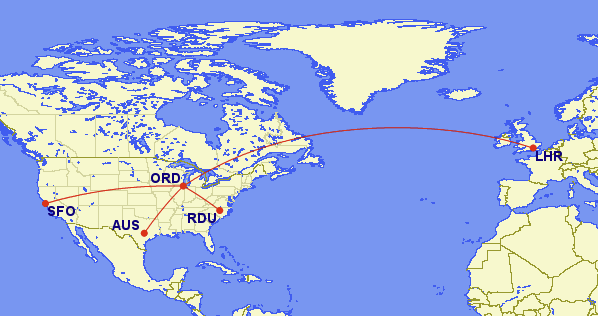I got a lot done today, mostly a bunch of smaller tasks I put off for a while. I also put off reading all of this, which I will do now while my rice cooks:
- The EU's Copernicus Climate Change Service determined that 2022 was the fifth-hottest year on record, once again making the last 8 years the hottest on record. As North America sees record warmth and record-low snowfall this winter, we can guess how 2023 will end up.
- In no small irony, Illinois was actually cooler than normal last year. I've said before, Chicago will look better and better as the world looks worse and worse.
- Loathsome creep Andrew Tate lost all four of his appeals to Romania's appellate court, so will remain in the country until his trial for human trafficking.
- A report by INRIX Research put London and Chicago at the top of the list of cities with the worst car traffic. Oddly, in a related study, London also ranked 10th and Chicago ranked 20th of cities with the best public transit.
- Delta Airlines' "free" wi-fi reminds passengers of the adage, when someone else pays, you're the product, not the customer.
Finally, I've mentioned heading to San Francisco this coming weekend, has gotten some rain. By "some" I mean over 350 mm of rain in the past 15 days, making it the rainiest two weeks since 1866. The weekend forecast does not look encouraging: rain likely, highs around 12, lows around 9, and yet more rain likely. I have never taken an umbrella to California before. First time for everything, I guess.
And now my rice is done.
After DJI decided it didn't want to abide by Google's privacy and security guidelines, and instead wants users to side-load their software (uh...just no), I haven't flown my drone in a while. Today I finally installed Litchi, started my drone, and...*bam*.
You don't want to discover that one of your propeller blades is broken when you start your aircraft. Trust me.
After I repaired the gimbal and replaced 5 of the 8 rotor blades (the crash broke a couple that were fine before I started the thing up), I did a short test flight that scared the bejeezus out of Cassie.
I also did an actual flight, up to about 30 meters vertical and 200 meters horizontal:

The sun might actually come out tomorrow, so watch this space!
The House will probably elect a Speaker before the end of March, so we probably won't set any records for majority-party dickery before the Congress even starts. (We might for what the 118th Congress does, though.) But with three ballots down and the guy who thought he'd get the job unable to get the last 19 votes he needs, it might take a few days.
Meanwhile:
Finally, a ground crew worker at Montgomery Airport in Alabama fell into a running jet engine on Saturday; the NTSB is investigating. Yecch.
We've now got two full years between us and 2020, and it does look like 2022 got mostly back to normal.
- The Daily Parker got 487 posts in 2022, 51 fewer than in 2021 and 25 below median. As usual, I posted the most in January (46) and fewest in November (37), creating a very tight statistical distribution with a standard deviation of 3.45. In other words: posting was pretty consistent month to month, but down overall from previous years.
- I flew 10 segments and 16,138 flight miles in 2022, low for the 21st century but about average for my lifetime.

- Once again, I visited only one other country (the UK, of course), but 8 other states: North Carolina, Indiana, Kentucky, Ohio, Wisconsin, California, Texas, and Michigan. In 2023, I plan to visit a bunch of new countries, but we'll see. Altogether I spent 107 hours traveling.
- I walked Cassie for a little more than 369 hours, somewhat fewer than in 2021 (422) but still an average of over an hour a day. It's about half as much as she wanted.
- I got 4,537,290 steps for 3,693 km of walking, a little below 2021 but about average overall. I only hit my step goal 327 times, though, due to no longer getting worked up about missing it in bad weather. I still averaged 12,393 a day, which doesn't suck.
- I drove 5,925 km on 144 L of gasoline, for an average of 2.4 L/100 km (96.4 MPG). The last four months of the year I used only 4 L of gas over 1,179 km, meaning I'm heading into 2023 with a nearly-full tank I last filled on August 21st. I do love living in the city!
- I worked 1,894 hours for my real job, including 1,260 from home and 580 in the office. The remainder went to conferences and work events. Plus, I spent 103 hours commuting, all of it by public transit (see above re: gasoline use).
- My commitment to the Apollo Chorus went up by a third this year, with 318 hours overall split between rehearsing and performing (220 hours) and my responsibilities as president (98 hours). Last year I spent 57 hours on rehearsals and performances and 71 hours on board stuff, but the first half of 2021 we were still virtual. In the last full year before the pandemic, 2019, I spent 200 hours overall (27 for the Board, 144 on rehearsals and performances, 29 for the fundraiser), so we really did do more this year than in years past.
- Finally, reading stayed the same, with 27 books started (cf. 28 in 2021) and 24 finished (cf. 23 in 2021)—both numbers exactly at median for me. But I watched a whopping (for me) 56 movies and 50 TV show seasons or miniseries. Yeek.
So, yeah, except for the permanent, post-pandemic shift to working from home 2/3 of the time, 2022 really did get back to normal in most ways. I'll take it. Here's to continued normal in 2023!
Speaking of loathsome, misogynist creeps, former Bishop of Rome Joseph Ratzinger died this morning, as groundbreaking journalist Barbara Walters did yesterday.
In other news showing that 2022 refuses to go quietly:
And just a couple of blocks from me, Uncharted Books will reopen next week after the state closed it down for failing to file a required sales-tax form. For months. They might want to fire their accountants for this, as the state requires every business that has taxable sales to file the "quarterly sales tax report" every 3 months. I hope their soon-to-be-former accountants also filed their income taxes...
Southwest Airlines, generally known for operational excellence, had a bad weekend from which they still have not recovered:
Tens of thousands of flights have been canceled across the country due to the winter storm and other issues, spoiling holiday plans for many — and Midway has been hit particularly hard by the Christmas chaos. As of Tuesday morning, at least 245 flights there had been canceled in the past 24 hours, according to the Department of Aviation.
Many cancellations are coming from budget staple Southwest Airlines, which is flying “roughly one-third of our schedule for the next several days,” a spokesperson said. Other reports say the airline is telling many travelers the earliest they can be rebooked is Dec. 31.
The U.S. Department of Transportation now says it will “examine” Southwest’s “unacceptable rate of cancellations and delays.”
What in the name of Daedalus happened? Details emerge:
In a statement on its website, Southwest called its own performance "unacceptable."
It said that while it was fully staffed for the holiday travel period, the brutal weather forced daily changes to its flight schedule "at a volume and magnitude that still has the tools our teams use to recover the airline operating at capacity."
Unlike many other U.S. air carriers, Southwest operates on what is known as a point-to-point flight route system, meaning a plane will fly consecutive routes, picking up different crews along the way.
In normal times, this can allow Southwest to operate more flights over a given 24-hour period than other carriers, said Scott Meyerowitz, executive editor of The Points Guy travel site.
But if an airport goes offline because of weather, and a flight cannot reach its destination, the point-to-point system has a cascading cancellation effect, he said.
The weather included a deadly snowstorm in Western New York that so far has left more than 30 people dead.
We get one or two every year. The National Weather Service predicts that by Friday morning, Chicago will have heavy snowfall and gale-force winds, just what everyone wants two days before Christmas. By Saturday afternoon we'll have clear skies—and -15°C temperatures with 400 mm of snow on the ground. Whee!
We get to share our misery with a sizeable portion of the country as the bomb cyclone develops over the next three days. At least, once its gone and we have a clear evening Saturday or Sunday, we can see all five of the naked-eye planets just after sunset.
Meanwhile, I'm about to start my team's Sprint 75 Review, the last one of 2022, which contains a few goodies we put off because we spent most of our time on client requests. We have a strange habit of doing what paying customers know they want before we add the things they don't know they want.
Meanwhile, elsewhere in the world:
Finally, director James Cameron ended all debate about whether Jack and Rose could both have survived in Titanic: "Cameron maintains that Jack simply had to die, telling The Sun that 'if I had to make the raft smaller, it would have been smaller.'" Because the story, you see, required it.
What a delight to wake up for the second day in a row and see the sun. After 13 consecutive days of blah, even the -11°C cold that encouraged Cassie and me to get her to day care at a trot didn't bother me too much.
Unfortunately, the weather forecast says a blizzard will (probably) hit us next weekend, so I guess I'll have time to read all of these stories sitting on the couch with my dog:
Finally, one of my college music professors died this month. Herbert Deutsch co-created the Moog synthesizer and taught at Hofstra University for 40-plus years.
I posted this morning about the decline in craft brewing that seems to have started, thanks to market saturation and the pandemic. Two other things have reached the ends of their runs as well, and both have deep Chicago connections.
First, Boeing this week rolled out its last 747 airplane. The 54-year-old design has come a long way, to the point where the 747-8i that left the Everett, Wash., factory on Tuesday has 150% the carrying capacity of the first 747-100 produced in 1968 (333 tonnes vs. 458 tonnes—just over 1 million pounds).
Second, the Lincoln Park Zoo plans to remove what could be the oldest tree in Chicago in the coming weeks. The bur oak, on the Zoo's south lawn by the white-cheeked gibbons, has grown in the spot for between 250 and 300 years, making it about as old as Händel's Messiah. The tree has a 117-cm diameter trunk and stands 13.7 meters tall. (Two other trees—an oak in Norwood Park and another bur oak by the University of Chicago—may be older.)
Time and chance happeneth to them all.
Meteorological winter begins in the Northern Hemisphere today. In Chicago right now we have sunny skies and a normal-for-December 2°C. And any day above freezing between December 1st and March 1st works for me.
Meanwhile:
Finally, on a whim I looked back at my posts from 10 years ago, and I came across this painful memory of debugging an Azure 1.8 deployment. And 15 years ago we got our first snowfall of the season. Ah, memories.